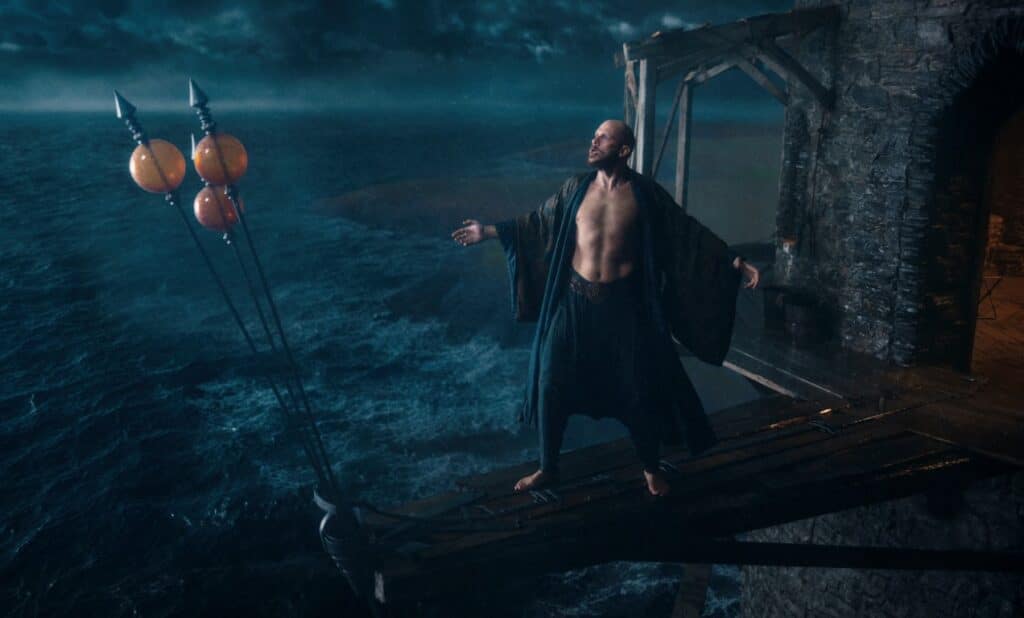Read also:
How to Watch FX Live Without CableHow To Watch AMC Without CableHow to Watch ABC Without CableHow to Watch Paramount Network Without CableFrank Miller’s adaptation of Arthurian legend is filled with sumptuous fantasy visuals, but there are gaps in the girl-power twist on the myth.
Any doubts about how well Frank Miller translates into Arthurian legends are put to rest within minutes of Cursed. For his latest venture, Miller and writer Tom Wheeler (adapting Miller’s young adult novel of the same name) have set out to (re)tell the origin story of The Lady of the Lake and how she came to possess the sword Excalibur. With trademark hyper-stylization and deliciously squishy viscera, this version of the story is a feast for the senses, but when it’s time for the plot to take over, the series grinds to a noticeable trot as so many medievalist projects tend to do.
Cursed follows Nimue (Katherine Langford), daughter of the high priestess of her fay clan as she’s forced to confront her destiny and battle merging enemies to save the magical way of life. Setting out with her pseudo-squire Pym (Lily Newmark) to meet the saucy and sauced sorcerer Merlin (Gustaf Skarsgård), they quickly get swept up in the bloodshed consuming the country and their paths become anything but certain. In her journey, Nimue joins with a dashing young knight Arthur (Devon Terrell) and a Fay resistance to try and topple Uther Pendragon’s (Sebastian Armesto) cruel reign and the bloody terror of conservative religious mercenary group the Red Paladins (led by Father Carden, played by Peter Mullan).
The world of this game of swords is gobsmacking and gorgeous at multiple points throughout the entire series. For better and worse, the pilot episode (directed with flair by Zetna Fuentes) has a clear visual and narrative thesis, showing you every subversive card Miller and Wheeler have up their sleeve. The stylized slaughter is scintillating to watch, and all the narrative threads are laid out succinctly. It gives you everything you need right up front.

Unfortunately, the archness of its presentation isn’t sustainable; there’s not enough intrigue in the plot to keep us at the edge of our seat. Suddenly, Miller and Wheeler’s dialogue becomes heavy with exposition, with lots of chewy sentences that don’t always feel natural. The characters and plot points feel a little more than blade-thin. Some may call these characters archetypes and therefore free from the burden of backstory, but the series is committed to making the story feel contemporary so this lack of depth feels hollow.
The series is clearly more of a stylistic experiment than a narrative one. It’s about looking at Arthurian lore through Frank Miller’s eyes more than trying to do a bold retelling of the legends themselves. The production design, visual effects, and soundscapes are rich in color and saturation. The world feels clean and distinctive.
But fear not, ye pilgrims of medieval fantasy! Budgets end. There is just enough soundstagery to recall the charming Avalon adventures of olde like Merlin (1998), The Mists of Avalon (2001) and Merlin (2008-2012).
Unfortunately, the archness of its presentation isn’t sustainable; there’s not enough intrigue in the plot to keep us at the edge of our seat.
Had Cursed been made at the same time as these other examples, its gender politics might feel more vibrant. In reality, there isn’t much to the fantasy of a feminist heroine, at least to the extent the show has been marketed as a medieval girl-boss show. Yes, Nimue has agency and power, but her narrative is the same masculinist one we’ve always been telling. She is of high rank who doesn’t want her power and the responsibility/uniqueness/individuality that comes with it, but learns to embrace them. She’s the reluctant leader born to greatness. Her gender rarely offers new possibilities.
The conscious feminism of the series is largely played out in the common Christians vs. Pagans dualism, with the magical folk implicitly and/or explicitly coded as feminine. We are to sympathize with their plight and thus see the kingdom and religious order as straw-castle stand-ins for patriarchy.
Though this is not an animal lovers’ Avalon, there’s ecofeminist potential here in the way the magic of the series is articulated as a feminine and bodily earth magic. But even this is fraught with old patriarchal myths about women’s place amongst nature as opposed to the masculine world of industry and development. Cursed makes complete its clumsy tightrope walk, but will need to build stronger support for any feminist goals it has for future seasons.

That said, how Fuentes collects and separates the threads at the end of the first episode is a compelling moment of feminist visual storytelling that took my breath away. There’s no need for visual effects. The magic comes as Fuentes elegantly melds camera and fight choreography to take terrifying rips out of the narrative tapestry to expose the horror of gendered violence that supports the world of the film.
There’s a lot of potential in this show. Its elementary ecofeminism and wonderfully disturbing imagery reach moments of the sublime which suggests there’s more underneath the shimmering surface of the lake. Hopefully, as the series goes on, it will become less of a trounce through medieval fantasy tropes, plodding over generic gender politics. Instead, it should embrace the divine feminine at its center and explore the threat-laden world it’s created for all the ways gender intersects with genocide, diaspora, and the magic of resistance.
Cursed tosses swords out of a lake and kicks ass with them on Netflix July 17th.